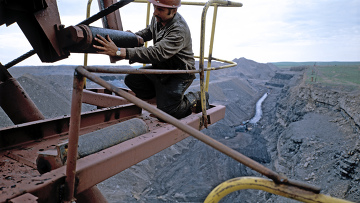© Press Service of the RNF
MOSCOW, Dec 21 - RIA Novosti . Scientists from the Kola Science Center of the Russian Academy of Sciences have created a three-dimensional model of the Kovdor carbonatite complex, the largest iron, phosphorus and zirconium deposit in Russia, an article published in the journal Minerals says .
One of the main problems for geologists, miners and industrialists is the assessment of how many minerals are contained in certain deposits. Today, scientists are trying to obtain such data in two ways - using costly "point" measurements at the field itself, and creating their computer models based on a relatively small number of samples from different parts of the rock strata and modern methods of computational mathematics and statistics.
Using this technique, Russian geologists created an accurate model of the Kovdorskoye deposit, one of the largest iron reserves and a number of other minerals on Earth, located in the west of the Murmansk region near the city of Kovdor.
In form it resembles a tube similar to kimberlite pipes with diamonds in Siberia and South Africa. The deposit is composed of rocks of magmatic origin, consisting of many minerals, including very rare ones, but olivine, magnetite, apatite and calcite predominate among them.
Three minerals are of industrial interest: magnetite, apatite and baddeleyite. Some of them go for processing in Russia, some - for abroad. Baddeleyite is used in the manufacture of all kinds of refractory substances and coatings for spacecraft, nuclear power, magnetite for iron, apatite for the production of phosphorus fertilizers and incendiary mixtures. All three minerals are mined in an open pit in one of the largest quarries in the Murmansk region.
"Carbonatite complexes are very rare objects, the study of which sheds light on the laws of the structure and evolution of the earth's crust, important for fundamental science.And the fact that a lot of remarkable minerals is associated with phosphorites and carbonatites attracts attention of specialists in practical geology" , The scientist continues.
To draw a map of this field, scientists have broken it into many blocks, only a small part of which was studied on the spot. In total, scientists extracted about 550 samples of rocks whose chemical and mineral composition helped them determine the contents of all the other blocks and understand how the Kovdorsky complex is arranged.
As it turned out, the "tube" is heterogeneous inside, they consist of layers of different mineral composition. For example, near the edges of the tube there are deposits of relatively useless olivine, in the center there were deposits of spar, and between them - deposits of iron ore, magnetite.
Understanding this peculiarity of the deposit, as the geologist notes, will allow industrialists to plan the extraction of iron ore and many other minerals for many years to come and spend the minimum amount of funds for the extraction of iron and other metals from it.
As a kind of bonus, scientists discovered two previously unknown minerals. The first of these is a campelite, a combination of phosphorus, scandium, magnesium and barium, which was named after Felix Kampel, the former technical director of Kovdorsky GOK. The second is hydroxynatropyrochlor, a compound of chlorine, niobium, sodium, and calcium.





No comments:
Post a Comment